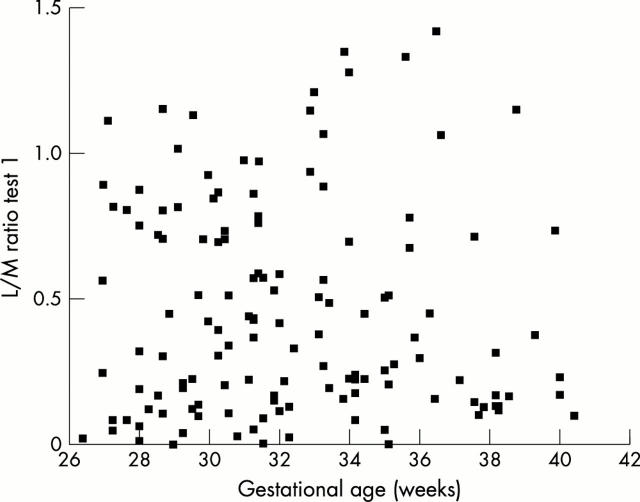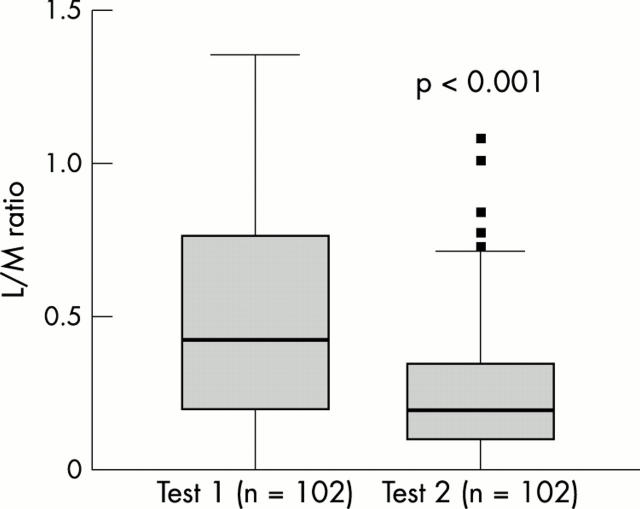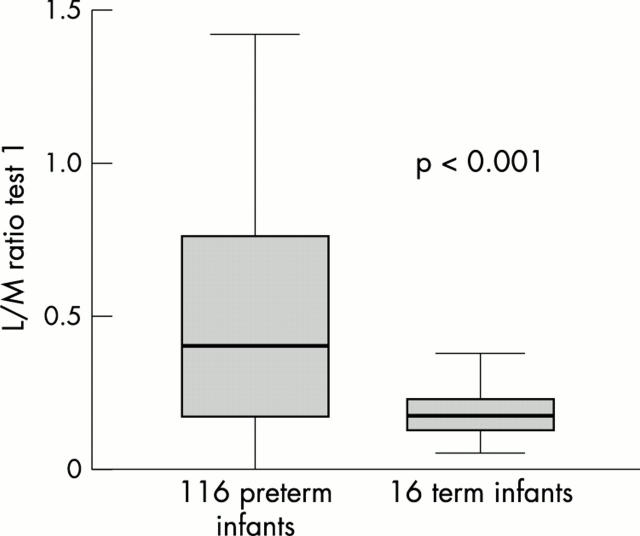Abstract
Objective: To determine the relation between intestinal permeability and birth weight, gestational age, postnatal age, and perinatal risk factors in neonates.
Study design: Intestinal permeability was measured by the sugar absorption test within two days of birth and three to six days later in preterm and healthy term infants. In the sugar absorption test, the urinary lactulose/mannitol ratio is measured after oral ingestion of a solution (375 mosm) of lactulose and mannitol.
Results: A first sugar absorption test was performed in 116 preterm (26–36 weeks gestation) and 16 term infants. A second test was performed in 102 preterm and nine term infants. In the preterm infants, the lactulose/mannitol ratio was not related to gestational age (r = -0.09, p = 0.32) or birth weight (r = 0.07, p = 0.43). The median lactulose/mannitol ratio was higher if measured less than two days after birth than when measured three to six days later (0.427 and 0.182 respectively, p<0.001). The lactulose/mannitol ratio was higher in preterm infants than term infants if measured within the first 2 days of life (0.404 and 0.170 respectively, p < 0.001), but not different three to six days later (0.182 and 0.123 respectively, p = 0.08). In multiple regression analysis of perinatal risk factors, only umbilical arterial pH correlated with the lactulose/mannitol ratio in preterm infants less than 2 days of age (T = -1.98, p = 0.05).
Conclusions: In preterm infants (26–36 weeks gestation), intestinal permeability is not related to gestational age or birth weight but is higher during the first 2 days of life than three to six days later. It is higher in preterm infants than in healthy term infants only if measured within two days of birth. This suggests rapid postnatal adaptation of the small intestine in preterm infants.
Full Text
The Full Text of this article is available as a PDF (98.7 KB).
Figure 1 .
Lactulose/mannitol (L/M) ratio in 116 preterm infants, measured within two days of birth, plotted against gestational age. They are not related (r = -0.09, p = 0.32).
Figure 2 .
Lactulose/mannitol (L/M) ratio in 102 preterm infants measured within two days of birth (test 1) and three to six days later (test 2). It was higher in test 1 (0.427) than in test 2 (0.182) (p < 0.001).
Figure 3 .
Lactulose/mannitol (L/M) ratio in 116 preterm infants and 16 healthy term infants measured within two days of birth (test 1). It was significantly higher in the preterm than the term infants (0.404 and 0.170 respectively, p < 0.001).
Selected References
These references are in PubMed. This may not be the complete list of references from this article.
- Akram S., Mourani S., Ou C. N., Rognerud C., Sadiq R., Goodgame R. W. Assessment of intestinal permeability with a two-hour urine collection. Dig Dis Sci. 1998 Sep;43(9):1946–1950. doi: 10.1023/a:1018826307489. [DOI] [PubMed] [Google Scholar]
- Beach R. C., Menzies I. S., Clayden G. S., Scopes J. W. Gastrointestinal permeability changes in the preterm neonate. Arch Dis Child. 1982 Feb;57(2):141–145. doi: 10.1136/adc.57.2.141. [DOI] [PMC free article] [PubMed] [Google Scholar]
- Catassi C., Bonucci A., Coppa G. V., Carlucci A., Giorgi P. L. Intestinal permeability changes during the first month: effect of natural versus artificial feeding. J Pediatr Gastroenterol Nutr. 1995 Nov;21(4):383–386. doi: 10.1097/00005176-199511000-00003. [DOI] [PubMed] [Google Scholar]
- Gray J. E., Richardson D. K., McCormick M. C., Workman-Daniels K., Goldmann D. A. Neonatal therapeutic intervention scoring system: a therapy-based severity-of-illness index. Pediatrics. 1992 Oct;90(4):561–567. [PubMed] [Google Scholar]
- Hadfield R. J., Sinclair D. G., Houldsworth P. E., Evans T. W. Effects of enteral and parenteral nutrition on gut mucosal permeability in the critically ill. Am J Respir Crit Care Med. 1995 Nov;152(5 Pt 1):1545–1548. doi: 10.1164/ajrccm.152.5.7582291. [DOI] [PubMed] [Google Scholar]
- Harris C. E., Griffiths R. D., Freestone N., Billington D., Atherton S. T., Macmillan R. R. Intestinal permeability in the critically ill. Intensive Care Med. 1992;18(1):38–41. doi: 10.1007/BF01706424. [DOI] [PubMed] [Google Scholar]
- Insoft R. M., Sanderson I. R., Walker W. A. Development of immune function in the intestine and its role in neonatal diseases. Pediatr Clin North Am. 1996 Apr;43(2):551–571. doi: 10.1016/s0031-3955(05)70420-x. [DOI] [PubMed] [Google Scholar]
- Neu J. Necrotizing enterocolitis: the search for a unifying pathogenic theory leading to prevention. Pediatr Clin North Am. 1996 Apr;43(2):409–432. doi: 10.1016/S0031-3955(05)70413-2. [DOI] [PMC free article] [PubMed] [Google Scholar]
- Roumen R. M., Hendriks T., Wevers R. A., Goris J. A. Intestinal permeability after severe trauma and hemorrhagic shock is increased without relation to septic complications. Arch Surg. 1993 Apr;128(4):453–457. doi: 10.1001/archsurg.1993.01420160095016. [DOI] [PubMed] [Google Scholar]
- Rouwet Ellen V., Heineman Erik, Buurman Wim A., ter Riet Gerben, Ramsay Graham, Blanco Carlos E. Intestinal permeability and carrier-mediated monosaccharide absorption in preterm neonates during the early postnatal period. Pediatr Res. 2002 Jan;51(1):64–70. doi: 10.1203/00006450-200201000-00012. [DOI] [PubMed] [Google Scholar]
- Shulman R. J., Schanler R. J., Lau C., Heitkemper M., Ou C. N., Smith E. O. Early feeding, antenatal glucocorticoids, and human milk decrease intestinal permeability in preterm infants. Pediatr Res. 1998 Oct;44(4):519–523. doi: 10.1203/00006450-199810000-00009. [DOI] [PubMed] [Google Scholar]
- Uil J. J., van Elburg R. M., Janssens P. M., Mulder C. J., Heymans H. S. Sensitivity of a hyperosmolar or "low"-osmolar test solution for sugar absorption in recognizing small intestinal mucosal damage in coeliac disease. Dig Liver Dis. 2000 Apr;32(3):195–200. doi: 10.1016/s1590-8658(00)80820-8. [DOI] [PubMed] [Google Scholar]
- Uil J. J., van Elburg R. M., van Overbeek F. M., Meyer J. W., Mulder C. J., Heymans H. S. Follow-up of treated coeliac patients: sugar absorption test and intestinal biopsies compared. Eur J Gastroenterol Hepatol. 1996 Mar;8(3):219–223. doi: 10.1097/00042737-199603000-00006. [DOI] [PubMed] [Google Scholar]
- Uil J. J., van Elburg R. M., van Overbeek F. M., Mulder C. J., VanBerge-Henegouwen G. P., Heymans H. S. Clinical implications of the sugar absorption test: intestinal permeability test to assess mucosal barrier function. Scand J Gastroenterol Suppl. 1997;223:70–78. [PubMed] [Google Scholar]
- Veereman-Wauters G. Neonatal gut development and postnatal adaptation. Eur J Pediatr. 1996 Aug;155(8):627–632. doi: 10.1007/BF01957141. [DOI] [PubMed] [Google Scholar]
- Weaver L. T., Laker M. F., Nelson R. Intestinal permeability in the newborn. Arch Dis Child. 1984 Mar;59(3):236–241. doi: 10.1136/adc.59.3.236. [DOI] [PMC free article] [PubMed] [Google Scholar]
- Weaver L. T., Laker M. F., Nelson R., Lucas A. Milk feeding and changes in intestinal permeability and morphology in the newborn. J Pediatr Gastroenterol Nutr. 1987 May-Jun;6(3):351–358. doi: 10.1097/00005176-198705000-00008. [DOI] [PubMed] [Google Scholar]
- Weaver L. T. Soy-based infant milk formulas and passive intestinal permeability. Lancet. 1989 May 6;1(8645):1023–1024. doi: 10.1016/s0140-6736(89)92669-x. [DOI] [PubMed] [Google Scholar]
- van Elburg R. M., Uil J. J., Kokke F. T., Mulder A. M., van de Broek W. G., Mulder C. J., Heymans H. S. Repeatability of the sugar-absorption test, using lactulose and mannitol, for measuring intestinal permeability for sugars. J Pediatr Gastroenterol Nutr. 1995 Feb;20(2):184–188. doi: 10.1097/00005176-199502000-00008. [DOI] [PubMed] [Google Scholar]
- van Elburg R. M., Uil J. J., Mulder C. J., Heymans H. S. Intestinal permeability in patients with coeliac disease and relatives of patients with coeliac disease. Gut. 1993 Mar;34(3):354–357. doi: 10.1136/gut.34.3.354. [DOI] [PMC free article] [PubMed] [Google Scholar]
- van Elburg R. M., Uil J. J., van Aalderen W. M., Mulder C. J., Heymans H. S. Intestinal permeability in exocrine pancreatic insufficiency due to cystic fibrosis or chronic pancreatitis. Pediatr Res. 1996 Jun;39(6):985–991. doi: 10.1203/00006450-199606000-00010. [DOI] [PubMed] [Google Scholar]





